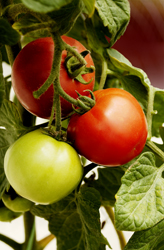Top up for tomato anti-oxidants
Eating flavonoids in fruit and vegetables is a pleasant, healthy way to decrease the risk of cardiovascular disease, cancer and other age-related diseases. However, levels of these anti-oxidants are kept under close control within the plant. The Profood project researched into what can be done to modify cell biochemistry to increase its nutrient value. The researchers' first line of attack was to increase the levels of precursor molecules, components of pathways leading to the final product. The scientists chose two molecules, phosphoenolpyruvate (PEP) and erythrose-4-phosphate (E4P), both important for flavonoid production. The new transgenic tomato plants showed overexpression of PEP in leaf plastids. As for E4P, the scientists harnessed the help of coding regions from other life forms ranging from Escherichia coli (E.coli) a moss species and spinach. Two important enzymes in the E4P molecular cascade showed accelerated activity, one in E.coli and the other in transgenic tomato plants. As an alternative approach to cheat the normal physiological controls of the plant, other transgenic tomato plants were engineered. These also produced enzymes involved in flavonoid synthesis, only this time in places in the plant not usually involved - so-called ectopic expression. The tomato is an ingredient in a huge variety of gourmet dishes and convenience foods. Further research could mean that pizza toppings will be giving an unexpected boost to dietary flavonoid content.

